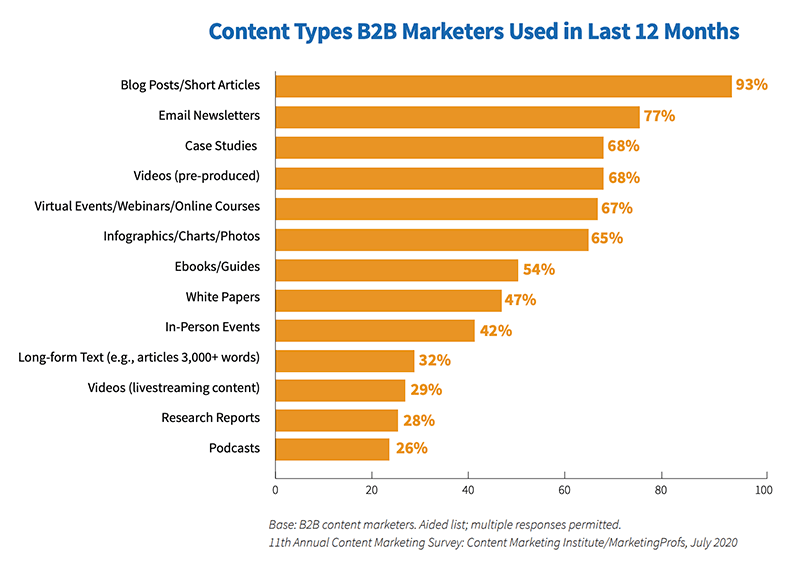Everybody has a blog, right? It’s long been the core of content marketing. It’s a resource covering all topics, personas, and funnel stages. However, just having a blog doesn’t mean it will deliver returns. Quality, throughput, relevancy, and promotion all play a role in getting content in front of audiences, making them want to trust and buy from you. To dig deep into why blogging matters, we sourced some of the most current blogging stats.
Yes, a Blog is Worth the Time and Investment
As an enterprise content team leader or member, you’re responsible for a variety of formats and types of content. Sometimes that might result in taking your eyes off your blog. However, doing so could dim your online visibility. Your blog is the space where you should consistently develop content that excites and educates. In looking at content usage, 93 percent of marketers use blogs, greater than any other.

Image Source: Content Marketing Institute
Your blog is a significant part of the execution of your content strategy. Within that, you should define frequency, pillar topics, keyword targets, voice and tone, and other parameters that drive quality. Those may include readability standards, content structure best practices, and content design requirements.
To provide you with ways to revamp your blog content strategy, create efficiencies, and other tips, check out these blogging stats.
Blogging and SEO Stats
Blogs are critical pieces of an SEO strategy. You’ll always optimize it to target specific keywords. When you create high-quality content that meets all the SEO best practices, you can expect more organic traffic. That traffic will likely be an engaged buyer.
Blogging Frequency Stats
Does how often you publish blogs matter? Yes, with caveats. A blogging frequency research project revealed there is a sweet spot. It depends on your company size, audience (B2B vs. B2C), and other factors. Generally speaking, regular posting drives more traffic and conversions. The ideal range is two to four posts a week.
While that can be an aspiration, don’t just crank out content. If the quality is poor and doesn’t deliver value to your audience, don’t rush your writers!
Blogging and Website Traffic Stats
Blogs are now the common entry point for new users. Often, this happens in organic search for high-ranking content. It may also be the result of social media posts or paid channels. No matter what the path is, it means more traffic. Organizations that blog see 55 percent more traffic than ones that don’t.
Another reason that blogs create more traffic is the infinite information that buyers now have access to, so they respond to blogging content better than ads. In fact, 70 percent of people would rather learn about companies through articles versus ads.
Blogging and Conversion Stats
This category of blogging stats demonstrates a blog’s ability to attract and convert audiences. Research suggests that marketers who prioritize blogging experience much greater ROI than those that don’t. Additionally, companies that blog average 67 percent more leads than their non-blogging counterparts.
Blogging and Nurturing Stats
Blogs are a key way to nurture a prospect from awareness to decision. Buyers have much different patterns in how they approach making purchasing decisions than ever before. In fact, B2B buyers, on average, consume 13 pieces of content during the purchase journey. Of that, eight are typically on your website.
Additionally, if you want to nurture to drive conversion, certain content types will best serve you. Those include product specifications, product comparisons, and success stories. All of these could be blog entries. See the chart below for the top six useful types of content.

Source: FocusVision
There’s more data to confirm content’s role in nurturing. Nearly three-fourths of content marketers say content successfully nurtures leads.
High-Performing Blogs Have These Attributes
This subset of blogging stats can help you optimize your content. To determine what commonalities your high-performing blogs have, you’ll start with a deep dive to identify those types of content by analyzing content analytics. Once you know which ones have the most traffic, clicks, and engagement, it’s time to find out why. As a framework, here are data points from research on what makes a successful blog.
Blogs with at least one image drive twice as much traffic. They also get 30 percent more shares and 25 percent more backlinks.
Do your high-performing blogs include images? Insert more images that add value to the post.
Complex structure in blogs (e.g., h2, h3, h4) perform the best.
Do your blogs include multiple sub-heads to break up the text? Consider adding more of these to enhance scanability.
Posts with at least one list every 500 words receive 70% more traffic.
Check if your top blogs use lists generously. Make that part of your blog guidelines when appropriate.
Headlines with 10 to 13 words experience twice as much traffic and 1.5 times more shares than those seven words or shorter.
Analyze the headline length of your blogs with the best metrics. Consider lengthening or shortening blogs to make them more enticing.
Long-form content receives 77.2 percent more links than shorter articles.
Look at the length of your blogs with backlinks. That can be a best practice for length. However, don’t just add words to stuff more content into an article that degrades its quality.
Blogging Stats to Shape Your Strategy
These stats clarify a lot of considerations in blogging. They can help you optimize your content, meet your production goals, engage audiences, and generate ROI. In looking at retooling your blog strategy based on this data, keep in mind:
- Quality over quantity.
- Repurposing and enhancing content should be ongoing.
- Be purposeful with SEO.
- Always consider your audience.
- Following best practices on frequency and length should be a guardrail, not an absolute.
Looking for more great blogging content? Read What Makes a Good Blog? The DNA of an Effective Business Blog.